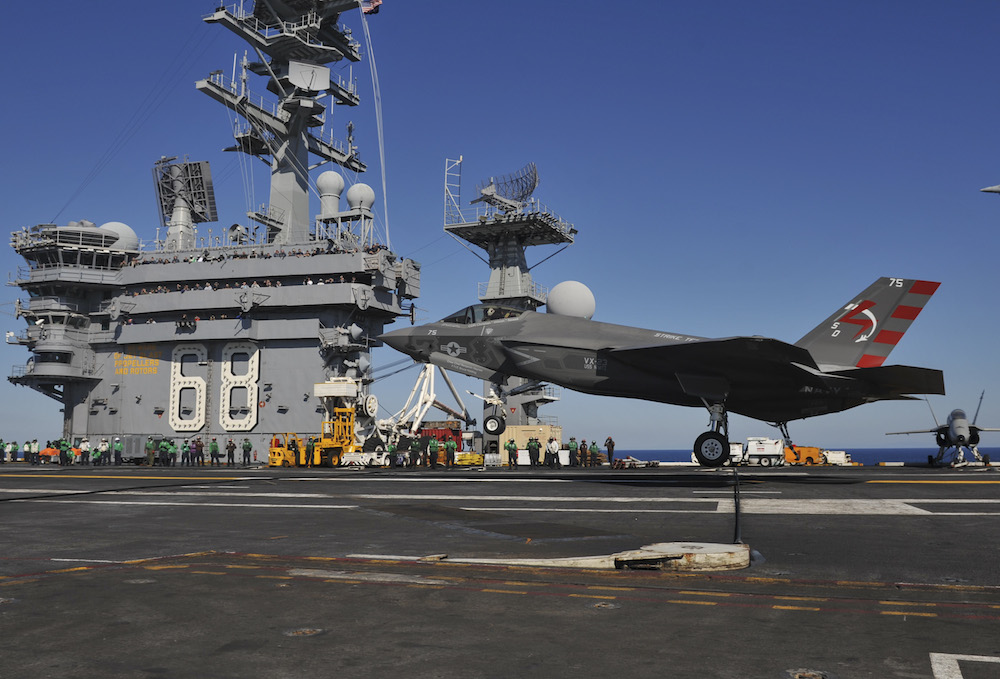Touchdown! F-35 Fighter Jet Nails 'Landmark' Aircraft Carrier Landing

This story was updated at 3:19 p.m. ET.
A next-generation F-35C fighter jet successfully landed aboard an aircraft carrier off the coast of San Diego yesterday (Nov. 3), marking a key milestone for the U.S. Navy.
It was the first time the Navy's newest fighter plane completed a so-called arrested landing at sea. The fighter jet, with Navy test pilot Cmdr. Tony Wilson at the controls, landed aboard the flight deck of the USS Nimitz yesterday at 12:18 p.m. local time (3:18 p.m. EST).
"Today is a landmark event in the development of the F-35C," Wilson said in a statement released Monday evening. [See more photos of the F-35C's aircraft carrier landing]
The maneuver is part of a two-week-long series of trials to evaluate how well the F-35C Lightning Carrier II performs within the tight confines of an aircraft carrier's flight deck.
Without a long runway, F-35 pilots — as well as crewmembers aboard the carriers — will have to perfect the modified landings and takeoffs that are the hallmarks of a fighter jet's life at sea.
Over the next two weeks, the planes will perform several repetitions of yesterday's arrested landing, in which mechanical systems are deployed aboard the carrier's flight deck to rapidly decelerate the airplane. The jet will also be taking off from the flight deck with the help of catapults, which generate enough lift to boost an F-35 into the air in just seconds.
Get the world’s most fascinating discoveries delivered straight to your inbox.
The test period is the first of three planned for the F-35C, according to Navy officials.
"This will be one landing out of thousands more that will happen over the next few decades," said Lt. Gen. Chris Bogdan, executive officer for the F-35 program. "We plan on learning a lot during this developmental test and will use that knowledge to make the naval variant of the F-35 an even more effective weapons platform."
The goal for this first round of tests is to collect data that will give engineers an idea of how well the F-35C performs on an aircraft carrier's flight deck. The results will then be used to optimize the plane for deployment at sea, which the Navy is hoping to do by 2018.
The F-35C carrier variant is one of several versions of the jet being built by Lockheed Martin. This version is designed to withstand life at sea, and includes durable exterior coatings, reinforced landing gear and other resilient components, according to Lockheed.
The plane's successful landing yesterday was a much-needed victory for Lockheed and the F-35 program. This summer, the U.S. military's entire fleet of F-35s was grounded after one of the planes caught fire during a routine takeoff in June.
The Air Force Safety Investigation Board inspected all of the approximately 104 jets in the fleet, aided in this effort by Lockheed Martin and officials from Pratt & Whitney, the government contractor that designs and produces the fighter jet's engine.
The investigators determined that a damaged fan blade in the engine of the plane caused the fire. Military officials declared the fire a "one-off incident"and flight restrictions on the F-35 were lifted in July, though Pratt & Whitney is reportedly working on new engine modifications for the jets, Aviation Week reported.
Editor's Note: This story was updated to correct the capabilities of the F-35C carrier variant. The F-35B is the fighter jet designed for short takeoff and vertical landings.
Follow Elizabeth Palermo @techEpalermo. Follow Live Science @livescience, Facebook & Google+. Original article on Live Science.


